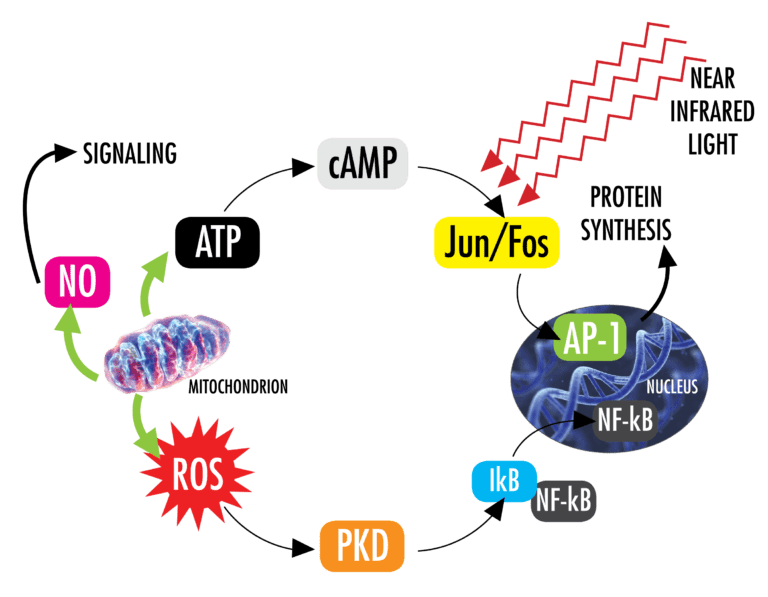Some Known Details About Photobiomodulation
Table of ContentsThe 4-Minute Rule for PhotobiomodulationIndicators on Photobiomodulation You Need To KnowThe Of PhotobiomodulationThe Best Strategy To Use For Photobiomodulation
Laser therapy is a clinical treatment that uses focused light to boost a process called. During PBM, photons go into the tissue and connect with the cytochrome c facility within mitochondria. This interaction causes an organic waterfall of events that leads to a rise in mobile metabolic process, which can along with accelerate the healing procedure.There is consensus that the application of a healing dose of light to damaged or inefficient tissue leads to a mobile reaction moderated by mitochondrial mechanisms. Photobiomodulation. Researches have actually shown that these adjustments can influence discomfort and swelling, in addition to, tissue repair service
Modifications in ATP, responsive oxygen types and nitric oxide comply with light absorption by Cc, O. These results are redox state and dose dependent. In hypoxic or otherwise stressed cells it has actually been shown sometimes that adhering to, nitric oxide is launched, ATP is boosted and oxidative anxiety is lowered [27-31]

How Photobiomodulation can Save You Time, Stress, and Money.
PBM tools have been gotten rid of for advertising and marketing by FDA with the Premarket Notification/510( k) procedure as adjunctive devices for the temporary alleviation of discomfort. These clearances were based upon the discussion of professional information to sustain such claims (Photobiomodulation). In this treatment, a light is placed near or touching the skin, permitting the light energy (photons) to permeate cells where it interacts with chromophores found in cells causing photophysical and photochemical changes that bring about modifications at the molecular, mobile and cells degrees of the body
Interestingly, current study shows that light can enhance performance in normal cells and cells. The possible applications of PBMT are various and are being checked out experimentally at the fundamental science, pre-clinical and professional level. The existing clinical uses are for the relief of discomfort and inflammation and the therapy of sporting activities injuries.

The therapy parameters and variety of sessions needed for PBMT are reliant upon location and reason. PBMT normally needs even more than one therapy for ideal discomfort alleviation. It may take a number of therapies for the results to come to be apparent. records that it can take anywhere from eight to 30 sessions for a therapy to be totally reliable, and some individuals locate it needed to go through therapy two to four times per week.
Photobiomodulation - Truths
Therapy criteria for PBMT were originally developed using cells in vitro and in little animal versions. These treatment criteria typically had a low irradiance and fluence and functioned well for cutaneous applications. When clinicians began to make use of PBMT to treat structures that were located much deeper in the body, they utilized these criteria with adverse results.
We now recognize that these unfavorable studies was because of incorrect tool and therapy criteria for transcutaneous treatment of deeper structures. Current breakthroughs in laser therapy gadgets and more research right into Discover More Here the ideal does have actually substantially improved the results of PBMT. For dealing with deep tissues, the wavelength of light used figures out the deepness of infiltration into a cells.
It is important that a clinician utilizes the proper wavelength of light and parameters to deal with a condition. One wavelength and one collection of treatment criteria will not be reliable for all conditions. Negative side you can try these out results have actually not been reported from the use of PBMT.
7 Easy Facts About Photobiomodulation Explained
In the initial experiment, Dr. Endre Mester, made use of cut rats and observing exactly how the laser impacted their capability to expand hair compared to the team that was not getting LLLT. He located that the team of computer mice obtaining LLLT had the ability to grow their hair back much more quickly than the team of mice that didn't receive LLLT (Hoon C, et al; 2012).
This treatment is described by doing this to separate the difference in between the lasers some careers use to cut (eg. in surgeries, or dental procedures). Low-level light therapy is painless, non-invasive therapy. It is used to reduce inflammation, swelling, and persistent joint conditions, lower pain and speed up injury recovery of nerves and cells (Hoon C, et alia; 2012).
LLLT has a biphasic response, meaning that reduced dosages are usually attended be extra helpful than greater doses. That being stated, doses higher or reduced than the ideal dose does not affect (Hoon C, et al; 2012). Because of this, it can be challenging to have researches on additional resources LLLT with a lot of criteria.
Some firms integrated the 2 (LED and laser) to offer an extra all-around therapy since lasers can pass through deeper than LED and infrared light (Norman Doidge, The Brain's Means of Healing, 2015). During treatment, the area that is being treated is subjected to LED light from a Biography, Flex Laser, which goes to 660 nm wavelength, complied with by infrared light at 830-840 nm wavelength.